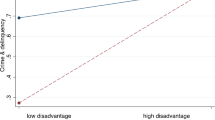Abstract
Individually measured factors and neighborhood context were related to juvenile delinquency in a community sample of 506 urban, public-school boys. Neighborhood context was measured with an objective, census-based score that classified neighborhoods as underclass or not underclass. When African American youths and white youths were compared without regard to neighborhood context, African American youths were more frequently and more seriously delinquent than white youths. When African American youths didnot live in underclass neighborhoods, their delinquent behavior was similar to that of the white youths. Hierarchical multiple regression analyses showed that boys' hyperactivity and parental supervision were the strongest correlates of delinquency. Single-parent status and poverty/welfare use were not related to delinquent behavior. Once individually measured factors were accounted for, residence in underclass neighborhoods was significantly related to delinquent behavior while ethnicity was not. This study points to the importance of including the neighborhood context when addressing the social problems of African American youths.
Similar content being viewed by others
References
Achenbach, T. M., and Edelbrock, C. S. (1983).Manual for the Child Behavior Checklist and Revised Child Behavior Profiles, Burlington, VT.
Coulton, C. J., and Pandey, S. (1992). Geographic concentration of poverty and risk to children in urban neighborhoods.Am. Behav. Sci. 34 (3): 238–257.
Crane, J. (1991). The epidemic theory of ghettos and neighborhood effects on dropping out and teenage childbearing.Am. J. Sociol. 96 (5): 1226–1259.
Currie, E. (1985).Confronting Crime: An American Challenge, Pantheon Books, New York.
Department of City Planning (1991).Pittsburgh Housing Study (Draft), Pittsburgh, PA, March.
Elliot, D. S., and Ageton, S. S. (1980). Reconciling race and class differences in self-reported and official estimates of delinquency.Am. Sociol. Rev. 45: 95–110.
Elliot, D. S., Huizinga, D., and Ageton, S. S. (1985).Explaining Delinquency and Drug Use, Sage, Beverly Hills; CA.
Farrington, D. P. (1992). Have any individual, family or neighborhood influences on offending been demonstrated conclusively? Paper presented at International Workshop, Integrating Individual and Ecological Aspects of Crime, Sweden.
Gottfredson, D. C., McNeil, R. J., and Gottfredson, G. D. (1991). Social area influences on delinquency: A multilevel analysis.J. Res. Crime Delinq. 28 (2): 197–226.
Gould, L. C. (1969). Who defines delinquency: A comparison of self-reported and officially reported indices of delinquency for three racial groups.Soc. Problems 16: 325–336.
Hogan, D. P., and Kitagawa, E. M. (1985). The impact of social status, family structure, and neighborhood on the fertility of black adolescents.Am. J. Sociol. 90 (4): 825–855.
Krohn, M. D., Stern, S. B., Thornberry, T. P., and Jang, S. J. (1992). Measurement of family process variables: The effect of adolescent and parent perceptions of family life on delinquent behavior.J. Quant. Criminal. 8 (3): 287–315.
Larzelere, R. E., and Patterson, G. R. (1990). Parental management: Mediator of the effect of socioeconomic status on early delinquency.Criminology 28 (2): 301–323.
Loeber, R., and Stouthamer-Loeber, M. (1986). Family factors as correlates and predictors of juvenile conduct problems and delinquency. In Tonry, M., and Morris, N. (eds.),Crime and Justice: An Annual Review of Research, Vol. 7, University of Chicago Press, Chicago, pp. 29–149.
Loeber, R., Stouthamer-Loeber, M., Van Kammen, W., and Farrington, D. P. (1991). Initiation, escalation and desistance in juvenile offending and their correlates.J. Crim. Law Criminol. 82 (1): 36–82.
Sampson, R. J., and Wilson, W. J. (1991). Toward a theory of race, crime, and urban inequality. Paper presented at the American Society of Criminology, San Francisco.
Shaw, C. R., and McKay, H. D. (1972).Juvenile Delinquency and Urban Areas: A Study of Rates of Delinquency in Relation to Differentiatial Characteristics of Local Communities in American Cities, University of Chicago Press, Chicago.
Siegel, W., and Senna, J. J. (1991).Juvenile Delinquency: Theory, Practice, and Law, West, St. Paul, MN, pp. 59–62.
Simcha-Fagan, O., and Schwartz, J. E. (1986). Neighborhood and delinquency: An assessment of contextual effects.Criminology 24 (4): 667–703.
Stouthamer-Loeber, M., Loeber, R., and Thomas, C. (1992). Caretakers seeking help for boys with disruptive and delinquent behavior.Comprehens. Ment. Health Care 2 (3): 159–178.
Williams, J. R., and Gold, M. (1972). From delinquent behavior to official delinquency.Soc. Problems 20: 209–229.
Wilson, W. J. (1987).The Truly Disadvantaged: The Inner City, the Underclass and Public Policy, University of Chicago Press, Chicago.
Wolfgang, M. E., Figlio, R. M., Tracy, P. E., and Singer, S. I. (1985).The National Survey of Crime Severity (NCJ-96017), U.S. Government Printing Office, Washington, D.C., June.
Author information
Authors and Affiliations
Rights and permissions
About this article
Cite this article
Peeples, F., Loeber, R. Do individual factors and neighborhood context explain ethnic differences in juvenile delinquency?. J Quant Criminol 10, 141–157 (1994). https://doi.org/10.1007/BF02221156
Issue Date:
DOI: https://doi.org/10.1007/BF02221156




